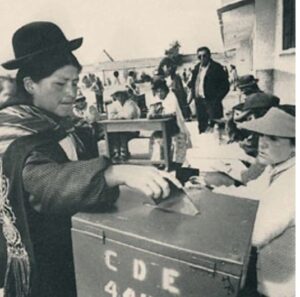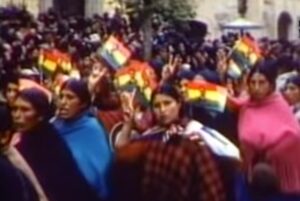About the Bolivian Revolution
In April 1952, a popular insurrection of urban and mine workers led by the Nationalist Revolutionary Movement (the MNR) overthrew the military junta that had taken power in May 1951. Nationalist movement leaders Víctor Paz Estenssoro (president) and Hernán Siles Zuazo (vice president) assumed power in 1952, and there the party remained for twelve years (1964).
In the first two years of government, the MNR launched a series of reforms that would constitute a milestone in Bolivian history. The party nationalized the mines that had been in the hands of three barons who controlled 80 percent of the country’s mining production; extended suffrage to women and Indians who had been on the margins of formal political participation; and distributed land to peasants that had been in the hands of landowners. These three transformations placed the Bolivian Revolution in the pantheon of the great social revolutions of twentieth-century Latin America.
The historiography of the revolution, especially studies published in the 1950s and 1960s, tended to emphasize the prominence of the MNR and its achievements. However, from the 1960s and 1970s onwards, several works, some from the left, became much more critical of the MNR and its achievements. Some spoke of the MNR’s close relationship with the U.S. State Department; others pointed out that the revolution had been incomplete if not betrayed. Since the 1980s, scholars who came from the ranks of Katarismo underlined the top-down character of the revolution that suppressed indigenous and peasant political projects and demands.
These readings of the revolution were deeply linked to political projects of the moment. As historian James Dunkerley observed, the Bolivian revolution was political rather than historical.
In 2003, historians Merilee Grindle and Pilar Domingo published a volume commemorating the 50th anniversary of the revolution. The book presented the most relevant contributions about it, and called for new studies daring to examine this process from new angles, with different eyes, and using novel sources.
In response to this call, especially over the last five years, we have seen a new wave of works reexamining the Bolivian revolution.
This website gathers this recent scholarship, providing an invaluable window to understand one of the greatest revolutions of Latin America in the twentieth century.
This project features nine short interviews, offering the public an entrée into the most current debates and assessments of the Bolivian Revolution’s achievements and unfinished endeavors.
We welcome you to explore this page, and the ideas and debates brought forward by these discussions.

